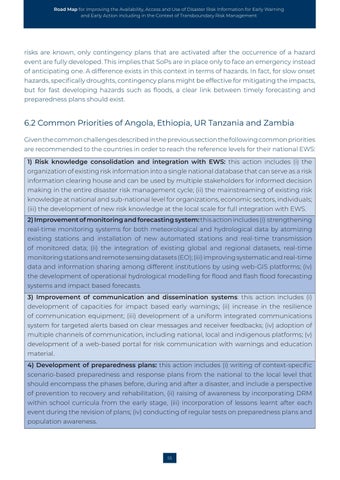Road Map for Improving the Availability, Access and Use of Disaster Risk Information for Early Warning and Early Action including in the Context of Transboundary Risk Management
risks are known, only contingency plans that are activated after the occurrence of a hazard event are fully developed. This implies that SoPs are in place only to face an emergency instead of anticipating one. A difference exists in this context in terms of hazards. In fact, for slow onset hazards, specifically droughts, contingency plans might be effective for mitigating the impacts, but for fast developing hazards such as floods, a clear link between timely forecasting and preparedness plans should exist.
6.2 Common Priorities of Angola, Ethiopia, UR Tanzania and Zambia Given the common challenges described in the previous section the following common priorities are recommended to the countries in order to reach the reference levels for their national EWS: 1) Risk knowledge consolidation and integration with EWS: this action includes (i) the organization of existing risk information into a single national database that can serve as a risk information clearing house and can be used by multiple stakeholders for informed decision making in the entire disaster risk management cycle; (ii) the mainstreaming of existing risk knowledge at national and sub-national level for organizations, economic sectors, individuals; (iii) the development of new risk knowledge at the local scale for full integration with EWS. 2) Improvement of monitoring and forecasting system: this action includes (i) strengthening real-time monitoring systems for both meteorological and hydrological data by atomizing existing stations and installation of new automated stations and real-time transmission of monitored data; (ii) the integration of existing global and regional datasets, real-time monitoring stations and remote sensing datasets (EO); (iii) improving systematic and real-time data and information sharing among different institutions by using web-GIS platforms; (iv) the development of operational hydrological modelling for flood and flash flood forecasting systems and impact based forecasts. 3) Improvement of communication and dissemination systems: this action includes (i) development of capacities for impact based early warnings; (ii) increase in the resilience of communication equipment; (iii) development of a uniform integrated communications system for targeted alerts based on clear messages and receiver feedbacks; (iv) adoption of multiple channels of communication, including national, local and indigenous platforms; (v) development of a web-based portal for risk communication with warnings and education material. 4) Development of preparedness plans: this action includes (i) writing of context-specific scenario-based preparedness and response plans from the national to the local level that should encompass the phases before, during and after a disaster, and include a perspective of prevention to recovery and rehabilitation, (ii) raising of awareness by incorporating DRM within school curricula from the early stage, (iii) incorporation of lessons learnt after each event during the revision of plans; (iv) conducting of regular tests on preparedness plans and population awareness.
55



